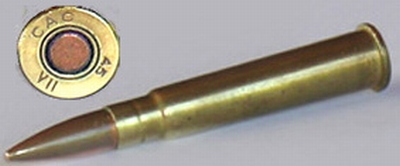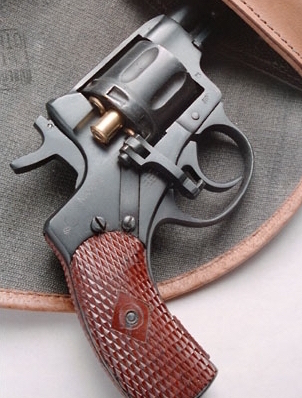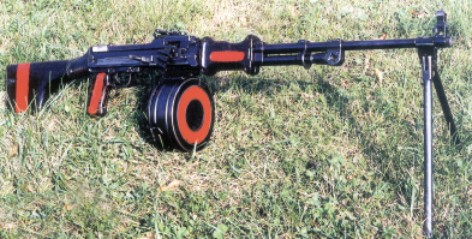|
7.62mm
The 7.62 mm caliber is a nominal caliber used for a number of different cartridges. Historically, this class of cartridge was commonly known as .30 caliber, the equivalent in Imperial and United States Customary measures. It is most commonly used in hunting cartridges. The measurement equals 0.30 inches or three decimal lines, written ''.3″'' and read as ''three-line''. The 7.62 mm designation refers to the internal diameter of the barrel at the lands (the raised helical ridges in rifled gun barrels). The actual bullet caliber is often , although Soviet weapons commonly use a bullet, as do older British ( .303 British) and Japanese ( 7.7×58mm Arisaka) cartridges. Pistol cartridges in 7.62 mm caliber Many pistol cartridges are in this caliber; the most common are: * 7.62×25mm Tokarev, also known as 7.62 mm TT, is used in the Tokarev pistol, and many of the World War II Soviet submachine guns * 7.63×25mm Mauser, which was the basis for, and has nearly ... [...More Info...] [...Related Items...] OR: [Wikipedia] [Google] [Baidu] |
PK Machine Gun
The PK (, transliterated as ''Pulemyot Kalashnikova'', or "Kalashnikov's machine gun"), is a belt-fed general-purpose machine gun, chambered for the 7.62×54mmR rimmed cartridge. The modernized and most commonly known variant, known as the PKM, features several enhancements over the original PK design. Designed in the Soviet Union and currently in production in Russia, the original PK machine gun was introduced in 1961 and the improved PKM variant was introduced in 1969. The PKM was designed to replace the SGM and RP-46 machine guns that were previously in Soviet service. The weapon remains in use as a front-line infantry and vehicle-mounted weapon with Russia's armed forces and has also been exported extensively and produced in several other countries under license. History The Main Artillery Directorate of the Soviet Union (GRAU) adopted specification requirements for a new 7.62 mm general-purpose company and battalion-level machine gun that was to be chambered for ... [...More Info...] [...Related Items...] OR: [Wikipedia] [Google] [Baidu] |
30-06 Springfield
The .30-06 Springfield cartridge (weaponry), cartridge (pronounced "thirty-Names for the number 0 in English, aught-six" ), 7.62×63mm in metric notation, and called the .30 Gov't '06 by Winchester, was introduced to the United States Army in 1906 and later standardization, standardized; it remained in military use until the late 1970s. In the cartridge's name, ".30" refers to the nominal caliber of the bullet in inches; "06" refers to the year the cartridge was adopted, 1906. It replaced the .30-03 Springfield, 6mm Lee Navy, and .30-40 Krag cartridges. The .30-06 remained the U.S. Army's primary rifle and machine gun cartridge for nearly 50 years before being replaced by the 7.62×51mm NATO and 5.56×45mm NATO, both of which remain in current U.S. and NATO service. The cartridge remains a very popular sporting round, with ammunition produced by all major manufacturers. History In the early-1890s, the U.S. military adopted the smokeless powder .30-40 Krag rimmed cartridge. The ... [...More Info...] [...Related Items...] OR: [Wikipedia] [Google] [Baidu] |
Mosin–Nagant
The Mosin–Nagant is a five-shot, Bolt action, bolt-action, Magazine (firearms), internal magazine–fed military rifle. Known officially as the 3-line rifle M1891, in Russia and the former Soviet Union as Mosin's rifle (, ISO 9: ) and informally just mosinka (), it is primarily chambered for the 7.62×54mmR Cartridge (firearms), cartridge. Developed from 1882 to 1891, it was used by the armed forces of the Russian Empire, the Soviet Union and various other states. It is one of the most mass-produced military bolt-action rifles in history, with over 37 million units produced since 1891. In spite of its age, it has been used in various conflicts around the world up to the present day. History Initial design and tests During the Russo-Turkish War (1877–1878), Imperial Russian troops armed mostly with single-shot Berdan rifles suffered heavy casualties against Ottoman Empire, Ottoman troops equipped with Winchester rifle#Model 1866, Winchester 1866 repeating rifles, particula ... [...More Info...] [...Related Items...] OR: [Wikipedia] [Google] [Baidu] |
Lee–Enfield
The Lee–Enfield is a bolt-action, magazine-fed repeating rifle that served as the main firearm of the military forces of the British Empire and Commonwealth during the first half of the 20th century, and was the standard service rifle of the British Armed Forces from its official adoption in 1895 until 1957. A redesign of the Lee–Metford (adopted by the British Army in 1888), the Lee–Enfield superseded it and the earlier Martini–Henry and Martini–Enfield rifles. It featured a ten-round box magazine which was loaded with the .303 British cartridge manually from the top, either one round at a time or by means of five-round chargers. The Lee–Enfield was the standard-issue weapon to rifle companies of the British Army, colonial armies (such as India and parts of Africa), and other Commonwealth nations in both the First and Second World Wars (such as Australia, New Zealand, South Africa, and Canada). Although officially replaced in the United Kingdom with the L1A ... [...More Info...] [...Related Items...] OR: [Wikipedia] [Google] [Baidu] |
303 British
The .303 British (designated as the 303 British by the C.I.P. and SAAMI) or 7.7×56mmR, is a calibre Rim (firearms)#Rimmed, rimmed Tapering (firearms), tapered bottleneck centerfire rifle Cartridge (firearms), cartridge. The .303-inch bore diameter is measured between rifling Rifling, lands as is the common practice in Europe which follows the traditional black powder convention. It was first manufactured in United Kingdom, Britain as a stop-gap black powder round put into service in December 1888 for the Lee–Metford rifle. From 1891 the cartridge used smokeless powder which had been the intention from the outset, but the decision on which smokeless powder to adopt had been delayed. It was the standard British and Commonwealth of Nations, Commonwealth military cartridge for rifles and machine guns from 1889 until it was replaced by the 7.62×51mm NATO in the 1950s. Cartridge specifications The .303 British has a 3.64 litre, mL (56 grain (measure), gr H2O) cartridge case capa ... [...More Info...] [...Related Items...] OR: [Wikipedia] [Google] [Baidu] |
AK-47
The AK-47, officially known as the Avtomat Kalashnikova (; also known as the Kalashnikov or just AK), is an assault rifle that is chambered for the 7.62×39mm cartridge. Developed in the Soviet Union by Russian small-arms designer Mikhail Kalashnikov, it is the originating firearm of the Kalashnikov rifle, Kalashnikov (or "AK") family of rifles. After more than seven decades since its creation, the AK-47 model and its variants remain one of the most popular and widely used firearms in the world. Design work on the AK-47 began in 1945. It was presented for official military trials in 1947, and, in 1948, the fixed-Stock (gun), stock version was introduced into active service for selected units of the Soviet Army. In early 1949, the AK was officially accepted by the Soviet Armed Forces and used by the majority of the member states of the Warsaw Pact. The model and its variants owe their global popularity to their reliability under harsh conditions, low production cost (compared t ... [...More Info...] [...Related Items...] OR: [Wikipedia] [Google] [Baidu] |
Nagant M1895
The Nagant M1895 is a seven-shot, gas-seal revolver designed and produced by Belgian industrialist Fabrique d'armes Émile et Léon Nagant, Léon Nagant for the Russian Empire. The Nagant M1895 was chambered for a proprietary cartridge, 7.62×38mmR, and features a gas-seal system, in which the cylinder moves forward when the gun is cocked, to close the gap between the cylinder and the Gun barrel, barrel, providing a boost to the muzzle velocity of the bullet and allowing the weapon to be Suppressor, suppressed. Its design would inspire the Pieper M1893 carbine and Steyr 1893 revolver. History The Nagant was designed by Léon Nagant, whose brother Émile had also taken part in designing the Mosin–Nagant rifle. The Nagant M1895 was adopted as the standard issue Sidearm (weapon), sidearm for the Imperial Russian Army and police officers, where it replaced earlier Smith & Wesson models such as the Smith & Wesson Model 3, Model 3.Kowner, '' Historical Dictionary of the Russo-Japan ... [...More Info...] [...Related Items...] OR: [Wikipedia] [Google] [Baidu] |
M1 Carbine
The M1 carbine (formally the United States carbine, caliber .30, M1) is a lightweight semi-automatic carbine chambered in the .30 carbine (7.62×33mm) cartridge that was issued to the U.S. military during World War II, the Korean War, and the Vietnam War. The M1 carbine was produced in several variants and was widely used by military, paramilitary, and police forces around the world after World War II, most notably by the armed forces of South Korea and South Vietnam. The M2 carbine is the selective-fire version of the M1 carbine, capable of firing in both semi-automatic and full-automatic. The M3 carbine was an M2 carbine with an active infrared scope system. Despite having a similar name and physical outward appearance, the M1 carbine is not a carbine version of the M1 Garand rifle. On 1 July 1925, the U.S. Army began using the current naming convention where the "M" is the designation for "Model" and the number represents the sequential development of equipment and ... [...More Info...] [...Related Items...] OR: [Wikipedia] [Google] [Baidu] |
Lee–Metford
The Lee–Metford (also known as the Magazine Lee–Metford) is a British bolt action rifle which combined James Paris Lee's rear-locking bolt system and detachable magazine with an innovative seven-groove rifled barrel designed by William Ellis Metford. It replaced the Martini–Henry as the standard service rifle of the British Empire in 1888, following nine years of development and trials, but remained in service for only a short time until replaced by the Lee–Enfield. Design Lee's bolt action mechanism was a : * The rear-mounted lugs placed the operating handle much closer to the rifleman, over the trigger. This made it much quicker to operate than other, forward-mounted lug designs which forced the rifleman to move his hand forward to operate the bolt. It also enabled the rifleman to operate the trigger with his middle finger while still holding the bolt between thumb and index finger. * The bolt's distance of travel was identical with the length of the cartridge, ... [...More Info...] [...Related Items...] OR: [Wikipedia] [Google] [Baidu] |
SVD (rifle)
The SVD (СВД; ), GRAU index 6V1, is a semi-automatic designated marksman rifle/sniper rifle chambered in the 7.62×54mmR cartridge, developed in the Soviet Union. History The SVD was designed to serve in a squad support role to provide precise long-range engagement capabilities to ordinary troops following the Warsaw Pact adoption of the 7.62×39mm intermediate cartridge and assault rifles as standard infantry weapon systems. At the time, NATO used battle rifles chambered for the 7.62×51mm NATO fully powered cartridge as standard infantry weapon systems and had not yet adopted an intermediate cartridge and assault rifle of their own, allowing them to outrange their Warsaw Pact counterparts. The SVD was developed through 1958–1963 and selected as the winner of a contest that included three competing groups of designers, led by Sergei Simonov (prototype rejected in April 1960), Aleksandr Konstantinov, and Yevgeny Dragunov. Extensive field testing of the rifles conducted ... [...More Info...] [...Related Items...] OR: [Wikipedia] [Google] [Baidu] |
308 Winchester
The .308 Winchester is a smokeless powder Rim (firearms), rimless bottlenecked rifle Cartridge (firearms), cartridge widely used for hunting, target shooting, police, military, and personal protection applications globally. It is similar, but not identical, to the 7.62×51mm NATO cartridge. History During the 1940s, the .300 Savage became the basis for experiments on behalf of the U.S. military that resulted in the development of the 7.62×51mm NATO#Development, T65 series of experimental cartridges. The original experimental case design by the Frankford Arsenal was designated "T65" and was similar to the .300 Savage case, but with less taper. The experimental cases were made from standard .30-06 Springfield cases which gave a little less capacity than standard .300 Savage cases because the Frankford Arsenal cases had slightly thicker walls. The later T65 iterations were lengthened compared to the original T65 case and provided a ballistic performance roughly equal to the U.S. mi ... [...More Info...] [...Related Items...] OR: [Wikipedia] [Google] [Baidu] |
RPD Machine Gun
The RPD (, English: Degtyaryov hand-held machine gun) is a 7.62x39mm light machine gun developed in the Soviet Union by Vasily Degtyaryov for the 7.62×39mm M43 intermediate cartridge. It was created as a replacement for the DP machine gun chambered for the 7.62×54mmR round. It is a precursor of most squad automatic weapons.Woźniak, Ryszard: ''Encyklopedia najnowszej broni palnej—tom 4 R–Z'', page 32. Bellona, 2002. It was succeeded in Soviet service by the RPK. History Work on the weapon commenced in 1943. Three prominent Soviet engineers were asked to submit their own designs: Vasily Degtyaryov, Sergei Simonov and Alexei Sudayev. Among the completed prototypes prepared for evaluation, the Degtyaryov design proved superior and was accepted into service with the Soviet armed forces as the 7.62 mm Ручной Пулемёт Дегтярёва, PПД (RPD, ''Ruchnoy Pulemyot Degtyaryova'' or "Degtyaryov light machine gun") model 1944. Although the R ... [...More Info...] [...Related Items...] OR: [Wikipedia] [Google] [Baidu] |











